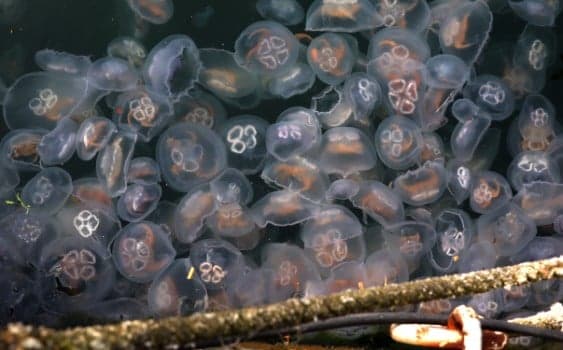Large jellyfish swarms spotted on Germany's Baltic Sea coast

If you are planning a staycation on the Baltic coast this summer - watch out for some wobbly companions wallowing in the water - and no we're not talking about naked German pensioners!
Oceanographers have observed unusually large numbers of jellyfish drifting through the Baltic sea this summer.
"Three weeks ago, we recorded a very dense blooming of moon jellyfish, some hair jellyfish and a few non-indigenous sea walnuts around Eckernförde Bay," oceanographer Cornelia Jaspers, from the Geomar Helmholtz Centre in Kiel, said.
READ ALSO: North of Baltic Sea? How to choose between Germany's two coasts
The explanation for the large swarms of jellyfish could lie in unusual movements of the sea’s currents last winter. Warm winter temperatures also likely contributed to the increased reproduction. The water was about five degrees warm - two degrees over the 40-year average.
"A lot of salty water from the North Sea and the Kattegat flowed into the southwestern Baltic Seal last winter,” says Jaspers.
This led to the strong emergence of sea walnuts, which feel particularly comfortable in salty water, says the oceanographer.
Native to the coasts of America, the sea walnut was brought to Europe in ballast water in the 1980s.
Since first being spotted in the Black Sea it has moved to other parts of the continent and has had a negative impact on fisheries due to its appetite for zooplankton.
They are not poisonous and therefore harmless to humans.
It's not only sea walnuts that now feel at home in the Baltic Sea. Jaspers has already discovered the "Blackfordia virginica" this year, which was first sighted in the Kiel Canal in 2014.
This species originally comes from the Black Sea. "It is also represented in large numbers and earlier than usual," the scientist says.
The southeast European jellyfish species loves brackish water and waters with low salt content. Jaspers fears that it could become an additional food competitor for Baltic Sea fish.
READ ALSO: Bloated jellyfish swarm German coastline
"Jellyfish are part of normal life," Jaspers says. “After all, they've been around for 550 million years. They're very primitive creatures."
For example, the endangered European eel in the Sargasso Sea is dependent on jellyfish for food.
"What key role jellyfish play in the ecosystem as a whole is an exciting question that is still largely unsolved," says Jaspers.
Key vocabulary
Jellyfish - (die) Qualle
Swarm/school - (der) Schwarm
Oceanography - (die) Ozeanographie
Sea currents - (die) Meeresströmungen
Eel - (der) Aal
We're aiming to help our readers improve their German by translating vocabulary from some of our news stories. Did you find this article useful? Let us know.
Comments
See Also
Oceanographers have observed unusually large numbers of jellyfish drifting through the Baltic sea this summer.
"Three weeks ago, we recorded a very dense blooming of moon jellyfish, some hair jellyfish and a few non-indigenous sea walnuts around Eckernförde Bay," oceanographer Cornelia Jaspers, from the Geomar Helmholtz Centre in Kiel, said.
READ ALSO: North of Baltic Sea? How to choose between Germany's two coasts
The explanation for the large swarms of jellyfish could lie in unusual movements of the sea’s currents last winter. Warm winter temperatures also likely contributed to the increased reproduction. The water was about five degrees warm - two degrees over the 40-year average.
"A lot of salty water from the North Sea and the Kattegat flowed into the southwestern Baltic Seal last winter,” says Jaspers.
This led to the strong emergence of sea walnuts, which feel particularly comfortable in salty water, says the oceanographer.
Native to the coasts of America, the sea walnut was brought to Europe in ballast water in the 1980s.
Since first being spotted in the Black Sea it has moved to other parts of the continent and has had a negative impact on fisheries due to its appetite for zooplankton.
They are not poisonous and therefore harmless to humans.
It's not only sea walnuts that now feel at home in the Baltic Sea. Jaspers has already discovered the "Blackfordia virginica" this year, which was first sighted in the Kiel Canal in 2014.
This species originally comes from the Black Sea. "It is also represented in large numbers and earlier than usual," the scientist says.
The southeast European jellyfish species loves brackish water and waters with low salt content. Jaspers fears that it could become an additional food competitor for Baltic Sea fish.
READ ALSO: Bloated jellyfish swarm German coastline
"Jellyfish are part of normal life," Jaspers says. “After all, they've been around for 550 million years. They're very primitive creatures."
For example, the endangered European eel in the Sargasso Sea is dependent on jellyfish for food.
"What key role jellyfish play in the ecosystem as a whole is an exciting question that is still largely unsolved," says Jaspers.
Key vocabulary
Jellyfish - (die) Qualle
Swarm/school - (der) Schwarm
Oceanography - (die) Ozeanographie
Sea currents - (die) Meeresströmungen
Eel - (der) Aal
We're aiming to help our readers improve their German by translating vocabulary from some of our news stories. Did you find this article useful? Let us know.
Join the conversation in our comments section below. Share your own views and experience and if you have a question or suggestion for our journalists then email us at [email protected].
Please keep comments civil, constructive and on topic – and make sure to read our terms of use before getting involved.
Please log in here to leave a comment.